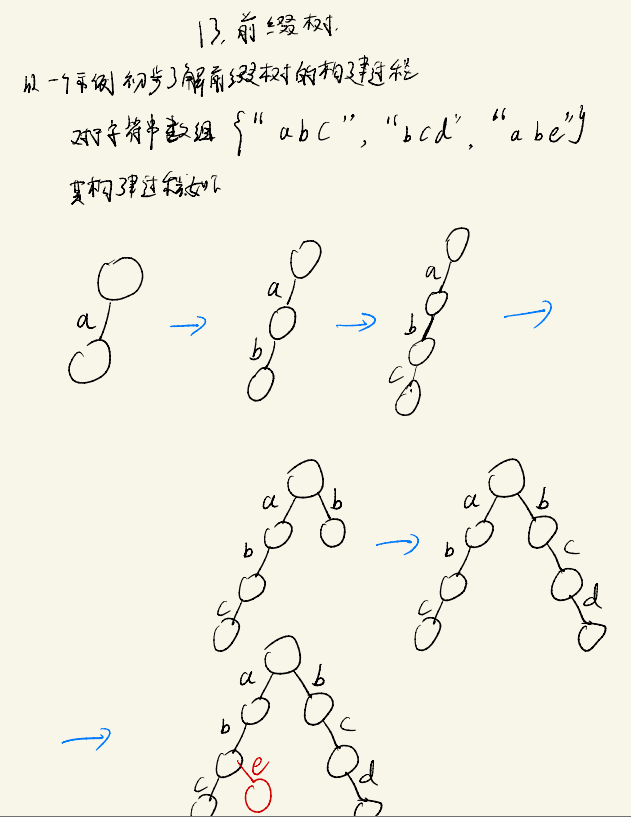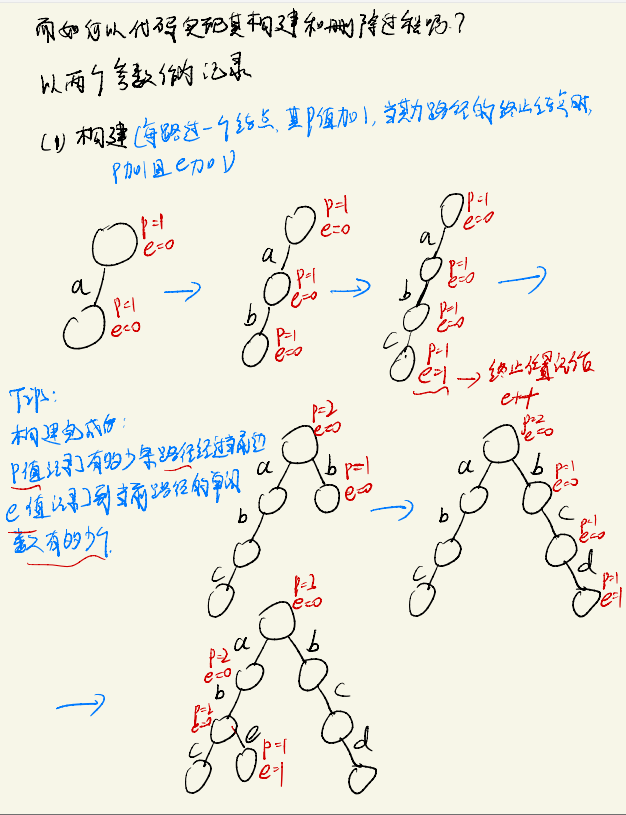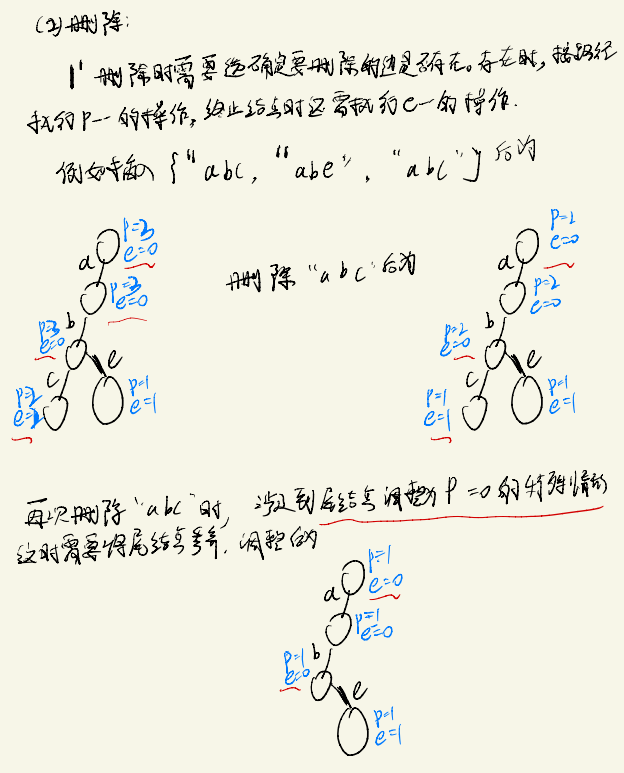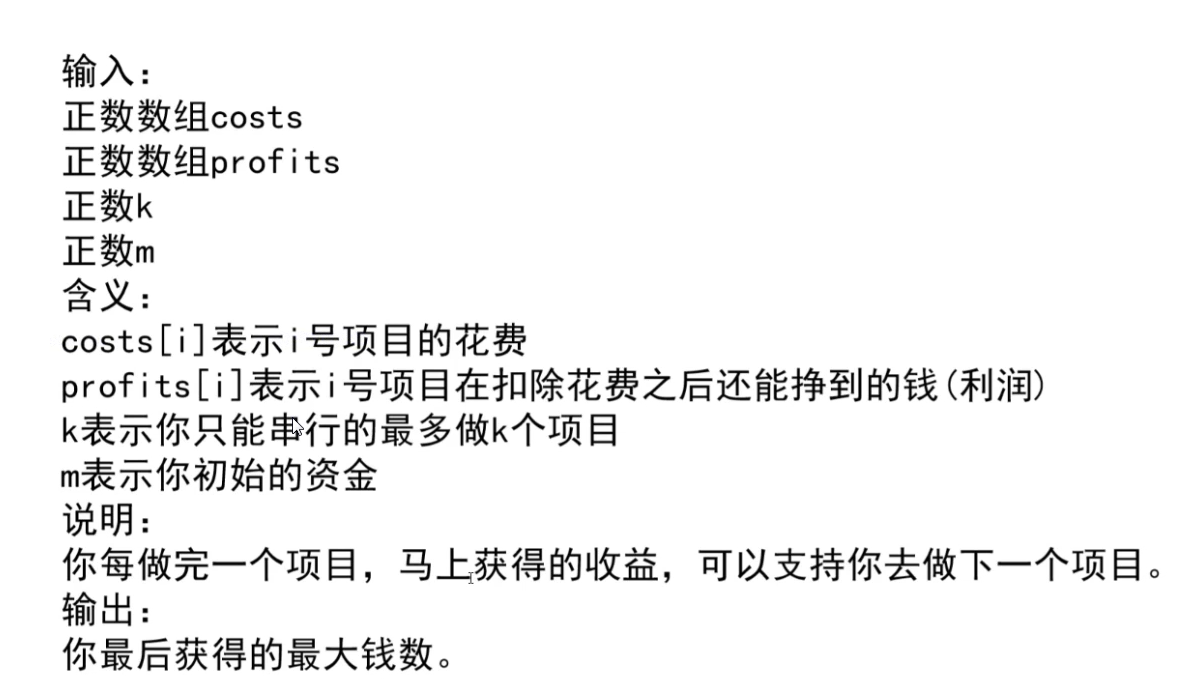前缀树
基本思路
前缀树用于存储字符串等数据的结构,其插入和删除流程大体如↓:



具体实现
1
2
3
4
5
6
7
8
9
10
11
12
13
14
15
16
17
18
19
20
21
22
23
24
25
26
27
28
29
30
31
32
33
34
35
36
37
38
39
40
41
42
43
44
45
46
47
48
49
50
51
52
53
54
55
56
57
58
59
60
61
62
63
64
65
66
67
68
69
70
71
72
73
74
75
76
77
78
79
80
81
82
83
84
85
86
87
88
89
90
91
92
93
94
95
96
97
98
99
100
101
102
103
104
105
106
107
108
| package p7.preTreeAndGreedy;
public class PreTree {
public class preNode{
int pass;
int end;
preNode[] nexts;
public preNode(){
pass = 0;
end = 0;
nexts = new preNode[26];
}
}
preNode root = new preNode();
public void insert(String word){
if(word == null){
return;
}
char[] arr = word.toCharArray();
preNode node = root;
node.pass++;
for (int i = 0; i < arr.length; i++) {
int index = arr[i] - 'a';
if(node.nexts[index] == null){
node.nexts[index] = new preNode();
}
node = node.nexts[index];
node.pass++;
}
node.end++;
}
public int search(String word){
if(word == null){
return 0;
}
preNode node = root;
char[] arr = word.toCharArray();
for (int i = 0; i < arr.length; i++) {
int index = arr[i] - 'a';
if(node.nexts[index] == null){
return 0;
}
node = node.nexts[index];
}
return node.end;
}
public int pathNumber(String word){
if(word == null){
return 0;
}
preNode node = root;
char[] arr = word.toCharArray();
for (int i = 0; i < arr.length; i++) {
int index = arr[i] - 'a';
if(node.nexts[index] == null){
return 0;
}
node = node.nexts[index];
}
return node.pass;
}
public void delete(String word){
if(word == null || search(word) == 0){
return;
}
char[] arr = word.toCharArray();
preNode node = root;
for (int i = 0; i < arr.length; i++) {
int index = arr[i] - 'a';
if(--node.nexts[index].pass == 0){
node.nexts[index] = null;
return;
}
}
--node.end;
}
}
|
贪心算法

经典贪心算法题解
会议室日程安排
题目:一个项目占用一个会议室,会议室同时只能被一个项目占用。给你每个项目的开始和结束时间,请给出最多能够完成多少场项目的宣讲,返回该场次数。
求解思路:
该问题的求解中贪心策略体现在,将尽可能早结束的会议安排进行程,就能得到最优解。
1
2
3
4
5
6
7
8
9
10
11
12
13
14
15
16
17
18
19
20
21
22
23
24
25
26
27
28
29
30
31
32
33
34
35
36
37
38
39
40
41
42
43
44
45
46
47
48
49
50
51
52
| package p7.preTreeAndGreedy;
import java.util.Arrays;
import java.util.Comparator;
public class Code02_Greedy_Room {
class roomTime{
int begin;
int end;
public roomTime(int begin, int end){
this.begin = begin;
this.end = end;
}
}
public class myComparator implements Comparator<roomTime>{
@Override
public int compare(roomTime o1, roomTime o2) {
return o1.end - o2.end;
}
}
public int maxNum(roomTime[] roomTimesSet, int timePot){
if(roomTimesSet == null){
return 0;
}
Arrays.sort(roomTimesSet, new myComparator());
if(timePot < roomTimesSet[0].begin){
return 0;
}
int res = 0;
for (int i = 0; i < roomTimesSet.length; i++) {
if(timePot <= roomTimesSet[i].end){
res++;
timePot = roomTimesSet[i].end;
}
}
return res;
}
}
|
分金条

算法思路:哈夫曼树,依托小根堆数据结构,每次取出小根堆顶端的两个数,求其和,将和累加进最小代价,并将和放入小根堆,重复此操作,直到小根堆不足两个数时,返回最小代价。
1
2
3
4
5
6
7
8
9
10
11
12
13
14
15
16
17
18
19
20
21
22
23
24
25
26
27
28
29
| package p7.preTreeAndGreedy;
import java.util.PriorityQueue;
public class Code03_Greedy_splitGold {
public int splitGold(int[] arr){
if(arr == null){
return 0;
}
PriorityQueue<Integer> queue = new PriorityQueue<>();
for (int i = 0; i < arr.length; i++) {
queue.add(arr[i]);
}
int res = 0;
while(queue.size() > 1){
int temp = queue.poll() + queue.poll();
res += temp;
queue.add(temp);
}
return res;
}
}
|
求最大资金数

该题求解思路为,每次选择能够执行项目中,利润最大的项目。这样本金能够得到最大程度的上升。
借助两个堆来实现该方案,首先借助一个小根堆,小根堆中依据项目所需本金升序排列项目,每次根据所拥有的本金从小根堆中出队列。出队列的项目入另一个大顶堆,大顶堆依据项目的利润降序排列。
1
2
3
4
5
6
7
8
9
10
11
12
13
14
15
16
17
18
19
20
21
22
23
24
25
26
27
28
29
30
31
32
33
34
35
36
37
38
39
40
41
42
43
44
45
46
47
48
49
50
51
52
53
54
55
56
57
58
59
60
61
62
63
64
65
66
| package p7.preTreeAndGreedy;
import java.util.Comparator;
import java.util.PriorityQueue;
public class Code03_Greedy_MaxMoney {
class project{
int cost;
int profit;
public project(int cost, int profit){
this.cost = cost;
this.profit = profit;
}
}
public class costComparator implements Comparator<project>{
@Override
public int compare(project o1, project o2) {
return o1.cost - o2.cost;
}
}
public class profitComparator implements Comparator<project>{
@Override
public int compare(project o1, project o2) {
return o2.profit - o1.profit;
}
}
public int maxMoney(project[] projects, int num, int money){
if(projects == null){
return 0;
}
PriorityQueue<project> minCostQueue = new PriorityQueue<>(new costComparator());
for (project p : projects) {
minCostQueue.add(p);
}
PriorityQueue<project> maxProfitQueue = new PriorityQueue<>(new profitComparator());
int res = money;
for (int i = 0; i < num; i++) {
while(!minCostQueue.isEmpty() && minCostQueue.peek().cost <= monry){
maxProfitQueue.add(minCostQueue.poll());
}
if(maxProfitQueue.isEmpty()){
return res;
}
res += maxProfitQueue.poll().profit;
}
return res;
}
}
|
拓展:如何通过1个大根堆+1个小根堆实现,实时返回一个数组的中位数?
规则如下:
- 第一个数直接入大根堆
- 后续进入的数,如果大于大根堆堆顶的数,入大根堆,否则入小根堆
- 如果大小堆size大小相差2,将size较大的堆堆顶元素出队,并入队另一个堆
这样,当大小堆size相等时,去两个堆堆顶元素的平均数,不想等时,取size较大那一个堆的堆顶元素,就能取得当前数组中位数。
总结
本节讲解了如何构建一颗前缀树,并实现对树的编辑。学习了贪心算法,需要注意的是贪心算法并没有固定的解题模板,其思路依据场景的变化而变化,需要多尝试,利用对比器进行检验,验证其有效性。







